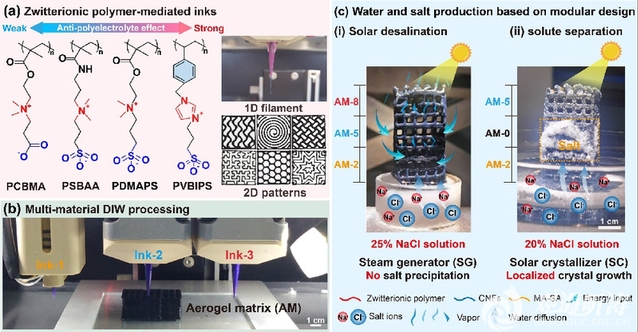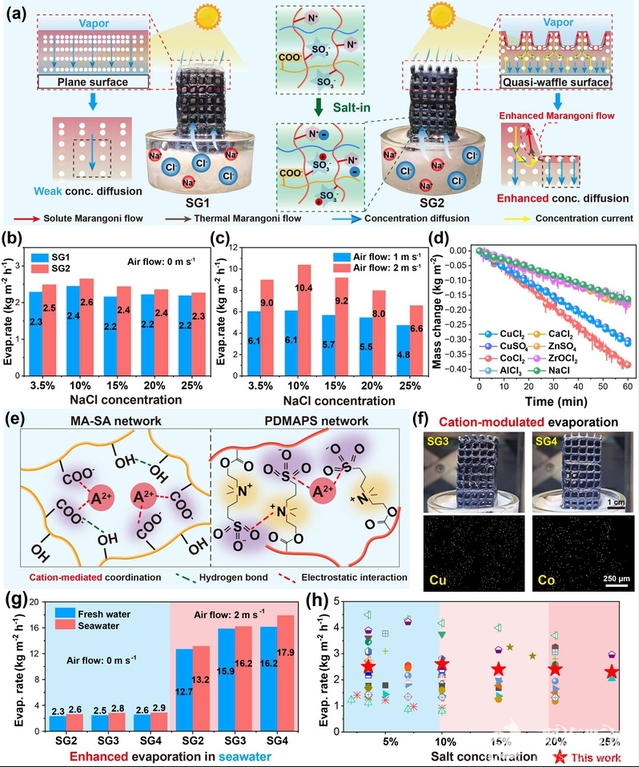Recently, this website reports Professor Xu Xiaofeng's research group from the Department of Polymer Materials and Engineering, College of Materials Science and Engineering, Ocean University of China, published a paper titled Tailor-Made Solar Desalination and Salt in the top international materials journal Advanced Materials The research results of Harvesting from Diverse Saline Water Enabled by Multi-Material Printing (Multi-material 3D printing for customizable photothermal interface evaporation and salt collection).
The problem of global freshwater shortage is becoming increasingly severe, seriously threatening the sustainable development of human society. In recent years, the emerging solar-driven interfacial evaporation technology has attracted much attention due to its advantages such as sustainability and low energy consumption, and has demonstrated unique advantages in the field of high-concentration brine desalination and resource utilization. However, the isotropic structure of traditional photothermal composites such as aerogels, hydrogels and foams limits the optimization of photothermal performance and the integrated application of multiple functions. Additive manufacturing (3D printing) is an effective method for preparing fine-structured materials. However, the photothermal composite materials prepared by the existing 3D printing technology have problems such as single pore structure, energy loss, mass transfer resistance and difficulty in salt crystallization regulation, making it difficult to achieve stable seawater desalination and resource utilization in high-salt environments.
In this project, through the multi-material ink direct writing technology (DIW), different photothermal inks can be precisely deposited at the designated spatial positions, successfully constructing a 3D photothermal matrix with a gradient structure. Solar interface evaporators (3D SGs) and solar crystallizers (3D SCs) with adjustable composition, structure and function were fabricated by collaboratively optimizing parameters such as ink formula, ion-regulated crosslinking network, printability and printability, and hierarchical porous structure. Efficient solar desalination, solute separation and salt collection were achieved within a wide salinity range (3.5%-25%) (Figure 1). This work has for the first time achieved the preparation of customizable shapes and functions of photothermal composite materials through multi-material 3D printing technology, enabling the photothermal materials not only to have a higher evaporation rate in seawater than in fresh water, but also to operate stably under high salinity conditions, thus realizing the application of solar energy coupled with concentrated brine desalination and resource utilization.

Figure 1. In this study, the design of photothermal ink for direct writing of multi-material ink and the printing and preparation of hierarchical structure printing of photothermal composites for desalination and crystallization of concentrated brine water.
Photothermal ink is mainly composed of fixed components such as cellulose nanofibers (CNFs), sodium methacrylate alginate (MA-SA), carbon nanotubes (CNTs), and variable components of different concentrations of amphoteric ion prepolymers (such as PDMAPS). These components work together to enhance the printability and printing accuracy of the ink, and also achieve functional adjustability.

Figure 2. Solar desalination and promotion of seawater evaporation.
The printing paths for three types of printing needles were customized. The three-dimensional structures were modeled by using the multi-layer superposition method, and the planar surfaces and Waffle surfaces were designed. The lattice structure with a waffle pattern surface and multi-scale stratified pores significantly increases the effective evaporation area, enabling better utilization of sunlight, air flow and environmental energy. The introduction of amphoteric ions in seawater has produced a significant anti-polyelectrolyte effect, shielding the interaction between polymer chain segments and exposing more ionic groups to interact with water molecules. The strong solvation effect of divalent cations also weakens the hydrogen bonds of water molecules and disrupts the original water molecule structure. These synergistic effects increased the intermediate water content, thereby accelerating the evaporation of 3D SGs. Under one sun and a wind speed of 2 m s−1, the maximum evaporation rate of 3D SGs in seawater reached 17.9 kg m−2h−1, which was 10.5% higher than that in fresh water under the same conditions and six times that in windless conditions. Even in 25% salt water, the evaporation rate could still be maintained at 6.6 kg m−2h−1. Stable and efficient water evaporation was achieved under a wide salinity range (3.5-25%) conditions (Figure 2).
Contrary to the conventional goal of achieving salt resistance, emerging fields such as solute separation, zero liquid discharge, and mineral resource recovery in seawater desalination have received extensive attention. Multi-material printing and its modular design can reorganize the photothermal matrix units, achieving confined solute separation and salt collection, and generating a salt collection rate of 269.3 g m−2h−1 in 20% brine. To evaluate the practical application performance, this work also simulated the evaporation rate and salt collection rate of 3D SGs and 3D SCs in seven major coastal cities and representative salt fields across the country, revealing the potential of multi-material printed photothermal composites in areas such as efficient clean water, solute separation, and sea salt production.
Li Jingjing, a 2023 doctoral student majoring in Marine Materials Science and Engineering at the School of Materials Science and Engineering, is the first author of the paper. This research was supported by the National Natural Science Foundation of China, the Shandong Province Taishan Scholars Program for Young Scholars, the Shandong Provincial Natural Science Foundation, and other projects, as well as with the assistance and support of foreign cooperative institutions and researchers from the UK, Sweden, Finland, and other countries.
Written by Li Jingjing
The article links: http://doi.org/10.1002/adma.202517244


